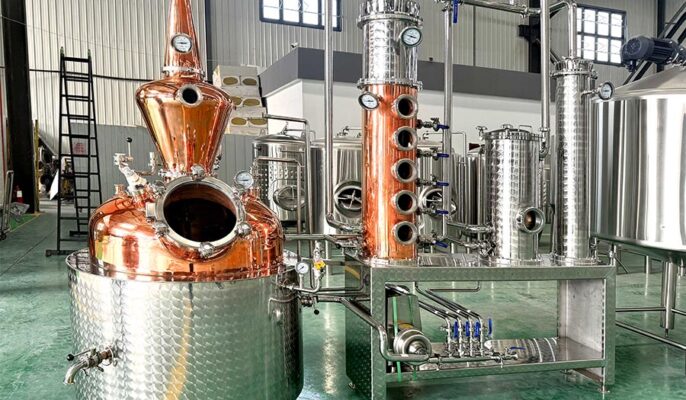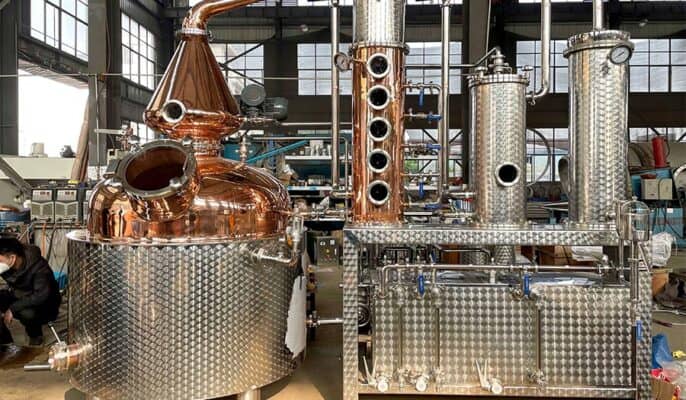Ausrüstung für die Destillation is widely used in the brewing industry and plays an important role in both food and beverage production industry processes. Whether you are an experienced distiller or a beginner just starting, choosing the right distillation equipment supplier is critical to achieving the desired results. Purchasing durable distilling brewing equipment is the foundation of running a successful distillery. To find the right equipment for your distillery, you must first broadly understand distillation.
What is alcohol distillation?
Distillation typically occurs in a tower where alcohol is separated from the wash liquor through multiple condensation and evaporation cycles. Alcohol vapor from the heated kettle rises into the tower where it passes through the bubbler and, depending on where you are in the run, meets a low alcohol bed on a plate. As the hot vapor meets the liquid bed, the heat is dispersed, which raises the temperature of the liquid bed and produces more vapor.
This heat transfer phenomenon occurs on each plate. The temperature of the liquid is lower. The temperature of the vapor is higher. The purer ethanol becomes vapor and condenses in the next cycle (each plate counts as one cycle). The more plate segments per tower, the higher the purity.

Types of Distillers
- Mirror Distiller: The mirror distiller is one of the oldest and most traditional types of distillation equipment. It usually consists of a large pot (mirror) and a condenser. The raw material is heated in the pot, and the vapor rises and passes through the condenser to become liquid. This type of equipment is suitable for making strong, single-flavored distilled spirits.
- Column still: Also known as a continuous still, the column still is a highly efficient piece of equipment. It consists of several continuously working columns, each with a specific function such as distillation, fractionation, and condensation. Column stills are typically used for large-scale production and produce a clearer and more neutral alcohol.
- Pot still: consists of a large pot, gooseneck tubing (also known as a Lane arm), and a condenser. The still heats the alcohol in the pot, forcing the vapors through the gooseneck tube, with some of the liquid dripping back into the pot and some of the vapors flowing to the condenser.
- Reflux distillation column: consists of a pot, a distillation column with copper plates, a Lane arm, and a condenser. The more distillation plates, the purer the alcohol. The fewer distillation plates, the more flavorful the alcohol.
The basic unit of a distillation unit
- Boiler or evaporator: The boiler is the central component of a distillation unit, used to heat the raw material and produce the vapors. It can be a simple heater or an evaporator with a complex structure, depending on the size and requirements of the distillation.
- Condenser: The condenser is used to cool the vapors rising from the boiler and condense them into a liquid. It usually consists of tubes or coils through which a cooling medium (e.g., cold water or coolant) passes to condense the vapors.
- Collection Vessel: The collection vessel is used to receive the condensed liquid product, such as alcohol or other distillation products. This is the collection and storage part of the final product of the distillation process.
- Thermometers and Pressure Gauges: Thermometers are used to monitor temperature changes during the distillation process to ensure that the distillation operation is carried out within the appropriate temperature range. Pressure gauges, on the other hand, are used to monitor vapor pressure and help regulate heating and cooling conditions.
- Other auxiliary equipment: These include exhaust systems, filters, pumps, etc., which are used to aid in the operation and handling of the distillation process.
The process of distillation
Distillation is the process of separating elements or substances from a liquid by a process of boiling and condensation. Each element must have a different boiling point to achieve an effective separation. The closer the boiling points of the elements in the liquid, the more complex the distillation process becomes.
Modes of distillation:
- Simple distillation: When two liquids have different boiling points, we use the simple distillation process. This distillation process is used to separate the liquid from the solid or non-volatile components. Simple distillation involves heating the liquid mixture to boiling point and condensing the vapors formed.
- Fractional Distillation: With the help of this distillation process we can separate the liquids in a mixture that has the same boiling point. In a fractional distillation column, evaporation and condensation steps are required. In this process, when the mixture is heated, the substance with a lower boiling point starts evaporating, condensing the liquid and separating it. Thereafter, the temperature rises and the boiling points of the components change from low to high boiling points.
- Steam distillation: Steam distillation is used to separate the heat-sensitive components of a mixture. To slightly heat and evaporate a portion, we pass steam through the mixture. The vapor formed is condensed and we get the necessary distillate. With the help of this process, we can obtain essential oils and herbal distillates from many aromatic flowers or herbs.
- Vacuum Distillation: We have to use a vacuum distillation process to separate the liquids in the mixture which have higher boiling points. Instead of heating these compounds at high temperatures to make them boil, we minimize the pressure in the surrounding environment. Due to the low pressure, the components will boil at low temperatures.
- When the vapor pressure of the compounds is equal to the surrounding environment, the compounds turn into vapors. These vapors then condense and collect as distillate. We can use this distillation process to obtain highly purified samples of compounds.
- Air Sensitive Vacuum Distillation: Certain compounds react when exposed to air. This air-sensitive vacuum distillation process is suitable for compounds that are air-sensitive and react with air. However, after the process is complete, we must replace the vacuum with an inert gas.

Ausrüstung für die Destillation heating methods
There are various heating methods for distillation equipment, and the choice of these methods depends on the specific distillation process, material properties, and equipment design. The most common are the following two heating methods: direct heating, indirect heating, and steam heating.
Direktheizung
This is one of the most common ways of heating distillation equipment, especially in traditional mirror stills. Direct heating transfers heat to the raw material by burning fuel (e.g., natural gas, firewood, coal, etc.) directly in a boiler or evaporator, or by using an electric heating element, which warms it up and produces vapor.
Indirect heating
Indirect heating means that the heating source does not act directly on the liquid, but transfers the heat to the liquid through heat exchangers, heating jackets, and other equipment. This way can avoid local overheating and improve evaporation efficiency, but the heating speed is relatively slow. Indirect heating realizes the distillation process by circulating the heating medium (e.g. thermal oil or steam) around the periphery of the boiler or evaporator so that the heat of the medium is transferred to the raw material inside.
Dampfheizung
Steam heating is a common option in some industrial and large-scale distilled brewing production. This method utilizes externally supplied steam to heat the boiler or evaporator, transferring heat to the feedstock through conduction and convection to achieve the distillation process.
Wie wählt man eine Destillationsanlage für die Brauerei aus?
- Define the production demand: According to the production scale and product demand, determine the processing capacity of the required equipment. Consider the daily production volume, peak production period, and equipment backup to ensure that the equipment processing capacity meets the production needs. For example, what type of liquor you need to process, the required separation purity, the size of your operation, etc.
- Types and sizes of distillation equipment: There are different types of distillation equipment, such as traditional mirror stills, column stills, and so on. Choosing the type of equipment depends on the type and size of the product you plan to produce. In terms of size, you need to choose the size of the equipment based on your production volume. Determine the processing capacity and capacity of the distillation equipment based on the size of the production or laboratory. The capacity of the equipment should be able to accommodate the volume of liquid to be processed per batch and take into account possible future expansion requirements.
- Budgetary considerations: Budget plays an important role in equipment selection. While it is important to find the equipment that best suits your needs, it is equally important to stay within budgetary constraints. Compare prices, but don’t compromise on quality and safety.
- Consider separation efficiency and purity requirements: Select the right distillation equipment based on product purity requirements and separation efficiency. Separation efficiency and energy consumption may vary between different types of equipment and need to be considered holistically.
- Consider material corrosion resistance and operating conditions: Select corrosion-resistant materials according to the chemical nature of the processed liquid and operating conditions to ensure the long-term stable operation and safety of the equipment. Commonly used materials include stainless steel, glass fiber-reinforced plastic, special alloys, and so on.
- Automation control system: selecting equipment with a high degree of automation can improve production efficiency and reduce labor costs. The use of advanced control systems, such as PLC (Programmable Logic Controller), touch screen, etc., is convenient for operators to set parameters, monitor the operating status of the equipment, and deal with abnormal situations.
- Supplier Reputation: Choose suppliers with good reputations and word-of-mouth to ensure that the quality of equipment and after-sales service is guaranteed. Solve the supplier’s after-sales service policy, including equipment installation and commissioning, technical training, maintenance, and other aspects of support.




